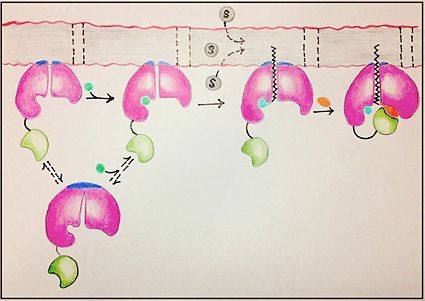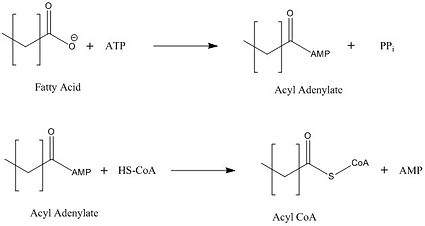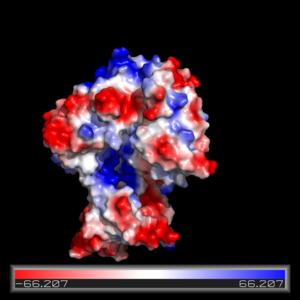Introduction
Mycobacterium tuberculosis very-long-chain fatty acyl-CoA synthetase, also known as FadD13, is unique within its class in regards to its ability to house lipid substrates longer than itself. Most FadD class proteins exist as integral membrane proteins involved in lipid transport into the cell. FadD13 is unique structurally in that it exists as a peripheral protein on the inside of the cell membrane.[1] This feature is key in the mechanistic basis for FadD13's activation and transport of fatty acids of length C24-C26 through the two step addition of Coenzyme A(Figure 1).[1]
FadD13 has be identified as key to the virulence of Mycobacterium tuberculosis, the etiological agent of tuberculosis, and has emerged as possible target for novel therapeutic agents.[2] The FadD13 enzyme is the last gene of the mymA operon. [3]
Mechanism

Figure 1: Mechanism for the activation of fatty acids (C24-C26) by FadD13. The N terminal domain (pink) is embedded in the membrane with the arginine rich lid-loop (dark blue), while the flexile linker (black) connects the C terminal domain (green) to the rest of the enzyme. Activation requires the binding of ATP (blue) which induces structural changes that promote the binding of the fatty acid chain. Formation of an acyl-adenylate intermediate induces a 140° rotation of the C terminal domain and the binding of CoA (orange).

Figure 2: Representation of the two-step reaction catalyzed by FadD13
General mechanism for the activation of fatty acids
FadD13 represents the first Fatty Acyl-CoA Synthetase of its kind to display biphasic kinetics.[3] FadD13 first activates the fatty acid through a reaction with ATP to form an acyl adenylate intermediate and subsequently releases a pyrophosphate. Following a conformational change of the enzyme, coenzyme A is able to bind and reaction with the acyl adenylate intermediate forming the acyl CoA product (Figure 2). These activated fatty acyl-CoA thioesters have then been demonstrated to be important for the synthesis of triacyglycerols and phospholipids in the membrane of Mycobacterium tuberculosis. [3]
Structural basis for housing lipid substrates longer than the enzyme
The ability for FadD13 to transport and activate fatty acids of the maximum tested length C26, lies in it being a peripheral membrane protein with a hydrophobic tunnel. FadD13 is attached to the membrane via electrostatic interactions in the N-terminal domain. Of importance in the region is the arginine rich lid-loop which serves to block the transport of fatty acids into the enzyme. Once the lid-loop is opened, fatty acids may be pulled from the membrane into a hydrophobic tunnel, which is the main structural component by which fatty acids are transported from the membrane into the cell. Negatively charged residues at the active site of FadD13 are the driving factor in the attraction of the fatty acid from the membrane through the hydrophobic tunnel of the enzyme.
Structure
FadD13 is composed of 503 amino acid residues divided into three main regions: The (residues 1-395) and (residues 402-503) which are connected via a flexible represented in dark blue (residues 396-401).[1] Each region plays an important role in the activation of fatty acids. The large N-terminal domain has the most structural features, but it is ultimately the flexible linker that allows movement of the C-terminal domain to from the fully functioning active site (Figure 1).
Electrostatics

Figure 3: Pmyol depiction of electrostatic interaction of FadD13.
The electrostatics of FadD13 as seen in (Figure 3) illustrate the hydrophobic and positively charged regions that compose this protein. Experimental results revealed that the peripheral FadD13 is attached to the membrane via electrostatic and hydrophobic regions located on the top portion of the N-terminal region (Figure 3).[1] Of key importance in this N-terminal domain region attached to the membrane is an area of notable arginine rich residues, known as the arginine rich lid-loop.
Arginine Rich Lid-loop
The functions to block entry of fatty acids into the hydrophobic tunnel of FadD13.This area on the top portion of the enzyme is also crucial in the association with the membrane as the positively charged arginine residues are attracted to the negative charge on the phospholipid heads.[1]
Hydrophobic Tunnel
The hydrophobic tunnel of FadD13 is essential to the transport and accommodation of very long fatty acids from the membrane into the cell. This tunnel runs through the middle of FadD13 from the arginine rich lid loop to the ATP binding site and is situated between the and alpha helices α8-α9 and parallel beta sheet β9- β14.[1]
Active Site
The active site on FadD13 is composed of two conserved regions, one of which serves as the binding site for ATP and the other for CoA. The adenine of ATP is bound to a group of that is structurally identically to other acyl-CoA synthetases. [1]
Mutational studies showed that high conserved residue in the C-terminal region, , resulted in a 95% loss of function of FadD13 and is thought to be involved in the orientation of the substrates to form the adenylate intermediate.[3] Additionally, Serine 404 was hypothesized to be involved in the binding of Coenzyme A which may only occur once this region incurs a 140 degree rotational change.[1][3]
Disease
Mycobacterium tuberculosis (M.tb) is the causative agent involved in the disease tuberculosis. Tuberculosis is a growing global health concern that has been intensified due to the increase in HIV infections along with the increase in multi-drug resistance strains of (M. tb) [4]. Most of the drug resistance has evolved due to the intensive nature of the treatment for tuberculosis, which often goes incomplete thus resulting in drug resistant strains; therefore, the importance in identifying characteristics and residues to be exploited for new drug targets is pivotal [4].
The cell wall of (M. tb) is known to be composed and synthesized from a distinct variety of lipids, most notably mycolic aicds, which are known to play a crucial role in pathogenesis of (M. tb) [4].
Relevance of key mutational studies to the understanding and development of new inhibitors for FadD13
[3]
Inhibitors
Future Research
This is a sample scene created with SAT to by Group, and another to make of the protein. You can make your own scenes on SAT starting from scratch or loading and editing one of these sample scenes.



